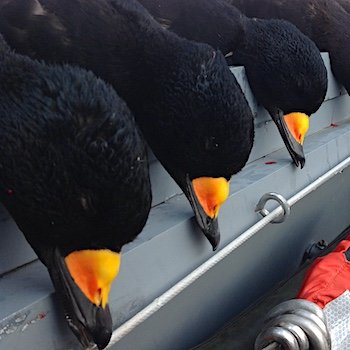Black Scoter

Black Scoter (Melanitta nigra americana), formerly referred to as the Common Scoter (Melanitta nigra), now differentiated as New World subspecies of the Eurasian Common Scoter but possibly worthy of full species status. The North American species is a medium-sized, velvety black sea duck distinguished by swollen, brightly colored yellow-orange bill knob. Remainder of bill is glossy black.
As seen at a distance, imagine seeing a little lemon or pumpkin resting on the bill. The rest of the bill matches the black plumage, legs, and feet. Black scoter hens lack the bill knob, but have the same, short black bill and display brown plumage with light gray brushed under the eyes. Immature males look similar to breeding females but to have a smaller, yellow knob that the breeding males possess.
Available Hunts
-
New England Sea Duck Hunting
World renown for its eider hunting, New England waterfowling offers an incredible change of scenery and is an excellent place to check off lots of North America waterfowl species. Codfather Charters specializes in making your hunt priorities a reality.
...read more- Decade-plus experience for trophy eiders, other sea ducks, divers, dabblers, mergansers, geese
- Best place in US to harvest prime American black ducks
- Customized hunt plans reflect hunter priorities, not a “one size fits all” type 1/2-day hunt
- Includes hotel accommodations, full-day hunting, continental breakfasts, made-to-order lunches
- Recognized as foremost among US waterfowl collectors and taxidermists
- Nearby non-hunting spouse activities abound
Rate: $2,500 for 3-day inclusive package -
Nova Scotia Sink Box Duck Hunting
Incredible sink box duck hunting in beautiful Nova Scotia Canada for scoters, long-tailed ducks and black ducks
...read moreStep into history and experience authentic Nova Scotia duck hunting. Banned in the US in 1918, sink box duck hunting in an exciting and effective means of putting unsuspecting ducks right on the deck.
- 20+ years sink box guiding experience
- November and December
- Unique experience, affordable rates
- Long-tailed Duck (oldsquaw) and American Black Ducks primarily
- Available only through GetDucks.com.
Rate: $2,500 -
Nova Scotia Sink Box Duck Hunting
Incredible sink box duck hunting in beautiful Nova Scotia Canada for scoters, long-tailed ducks and black ducks
...read moreStep into history and experience authentic Nova Scotia duck hunting. Banned in the US in 1918, sink box duck hunting in an exciting and effective means of putting unsuspecting ducks right on the deck.
- 20+ years sink box guiding experience
- November only
- Unique experience, affordable rates
- Long-tailed Duck (oldsquaw) and American Black Ducks primarily
- Choose 1x hunt daily, either sink box hunt or black ducks
- Available exclusively at GetDucks USHuntList
Rate: $2,800
 During winter, black scoter pairing begins. Breeding areas in North America are separated by the Western and Eastern populations and are dictated by where there are grasses and sedges near water within boreal forests for comfortable nesting. The Western Population is found in coastal Alaska, but Black Scoters will also breed in the interior. The Eastern Population is found mainly in Quebec, but appear in Newfoundland, Ontario, and Labrador. Males are protective of their mates and will be aggressive to other Black Scoters; that is, until the eggs have been laid. Males will then leave to molt while the young are reared by the females. This species will form small flocks and are often seen with other scoter species while foraging. The breeding season diet for this species of divers consists of insects, insect larvae, and fish eggs.
During winter, black scoter pairing begins. Breeding areas in North America are separated by the Western and Eastern populations and are dictated by where there are grasses and sedges near water within boreal forests for comfortable nesting. The Western Population is found in coastal Alaska, but Black Scoters will also breed in the interior. The Eastern Population is found mainly in Quebec, but appear in Newfoundland, Ontario, and Labrador. Males are protective of their mates and will be aggressive to other Black Scoters; that is, until the eggs have been laid. Males will then leave to molt while the young are reared by the females. This species will form small flocks and are often seen with other scoter species while foraging. The breeding season diet for this species of divers consists of insects, insect larvae, and fish eggs.
Despite preferring smaller flock waves when foraging, Black Scoters are gregarious and will migrate together in massive flocks after molting and can be found in areas of shallow waters that offer ample shellfish. Western and Eastern Populations are found along their respective coastlines on the Pacific and Atlantic, stretching the entirety of North America besides Mexico. Black Scoter diet is made up of snails, clams, mussels, and goose barnacles. Those that migrate to the Pacific Coast take advantage of spawning herrings in the Spring.







